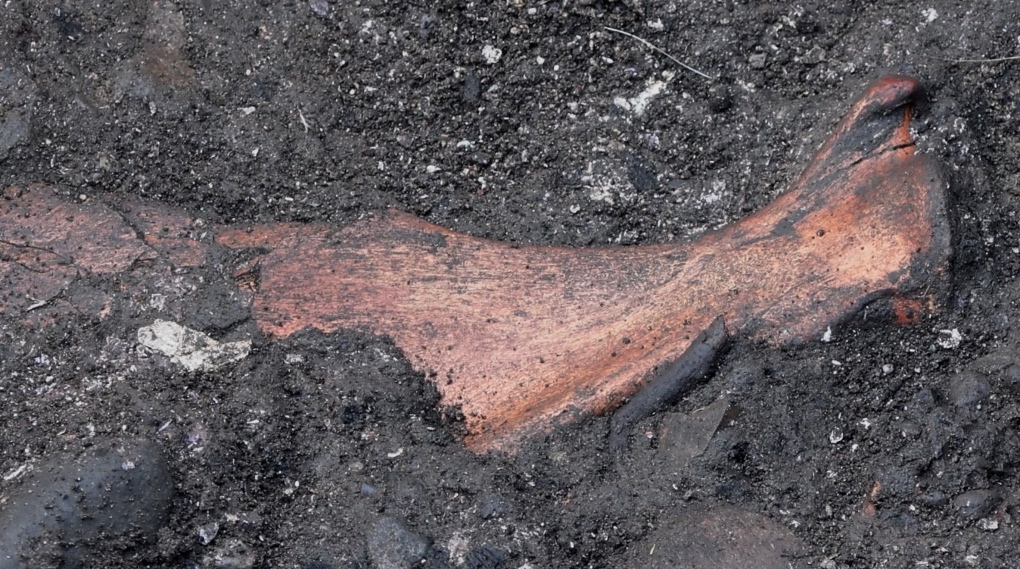Saanich archaeological dig reveals centuries of Indigenous history
At Agate Park in Cordova Bay, history is being revealed. Generations of First Nations' oral history has been confirmed at a thriving community that once was.
“We’re at the ancient village site of ȾEL¸IȽĆE,” said Brian Thom, associate professor of anthropology at the University of Victoria, who is leading the three-week dig.
“[We're] going through the layers and levels of the soils, finding everywhere we look the footprint of the old village that sat here for 1,000 years,” said Thom.
The dig is a partnership between the University of Victoria and a number of local First Nation communities.
“It’s very emotional for me,” said Roger Charlie, a Tsartlip First Nation band member.
Charlie has been told stories his whole life from elders about the vibrancy of this nearly forgotten village.
“About big feasts that used to be here and all the canoes that used to be lined up down here,” said Charlie.
Around two dozen people have been working the site, finding shell middens, as well as fishing and hunting tools.
“This is an elk tooth,” said Kaia Carr-Mehan, a third-year anthropology student at the University of Victoria.
Evidence was uncovered of a once abundant elk population on southern Vancouver Island.
“We have a large, like a shocking large, amount of elk remains at this site,” said Carr-Mehan.
Within one particular hole the team has just discovered a shoulder bone from one of those elk.
It’s thought the village once housed a population of around 250 people – a population that worked the entire geographical area.
“Just that short paddle down the way is where people had a very productive fish trap,” said Thom, pointing south along the beach.
 An elk shoulder bone discovered at the Saanich dig site. According to evidence gathered throughout the three-week dig, southern Vancouver Island once had a thriving elk population. (CTV News)
An elk shoulder bone discovered at the Saanich dig site. According to evidence gathered throughout the three-week dig, southern Vancouver Island once had a thriving elk population. (CTV News)
The beginning of July saw extremely low tides, revealing a first for the region.
“We did the first documentation of a fish trap in the South Island area,” said Thom. “It was very exciting.”
“I feel very honoured to be invited here,” said Darian Claxton, a Tsawout First Nation band member.
Over the past three weeks, he has discovered he has greater ties to the dig site than first imagined.
“My Auntie Belinda’s mother Elcie Claxton was actually from this village site,” said Claxton.
The dig is a picture frozen in time, a village colonial records show disappeared around 1870.
The excavation ended on Wednesday.
“There are more questions to answer but that will be for a future day,” said Thom.
What the dig has revealed is a better understanding of the people who once called Cordova Bay home and how they thrived for more than 1,000 years.
CTVNews.ca Top Stories

Should sex abuse evidence set the Menendez brothers free? A judge will decide
A judge will decide Monday whether new evidence warrants a re-examination of the convictions of Erik and Lyle Menendez in the shotgun murders of their parents in their Beverly Hills home more than 30 years ago.
Second Cup closes Montreal franchise over hateful incident
Second Cup Café has closed two of its franchise locations in Montreal following allegations of hateful remarks and gestures made by the franchisee in a video that was widely circulated online during a pro-Palestinian protest.
Egyptian officials say 17 people are missing after a tourist yacht sank in high waves on Red Sea
At least 17 people are missing after a tourist yacht sank in the Red Sea following warnings about rough seas, Egyptian officials said Monday.
Winnipeg police shoot, kill suspect after officer stabbed in the throat
A Winnipeg Police Service officer is recovering after he was stabbed in the throat Sunday evening.
'A first for everyone': Toronto traffic forces Utah Hockey Club to walk to Leafs game
The Utah Hockey Club got the full Toronto experience Sunday night ahead of their first-ever matchup against the Maple Leafs—bumper-to-bumper traffic that forced the team to walk to the game.
Elliot Lake, Ont., woman charged with choking neighbour's dog
An intoxicated woman in Elliot Lake has been charged with breaking into her neighbour's apartment and choking their dog.
DHL cargo plane crashes and skids into a house in Lithuania, killing Spanish crew member
A DHL cargo plane crashed on approach to an airport in Lithuania's capital and skidded into a house Monday morning, killing a Spanish crew member but not harming anyone on the ground. The cause is under investigation.
Cargo ship runs aground in St. Lawrence River near Morrisburg, Ont.
A large cargo ship remains stuck in the St. Lawrence River after running aground on Saturday afternoon.
Horse's head and pregnant cow used in 'barbaric' mafia threat in Sicily
The discovery of a severed horse head, and a cow quartered with its bloodied dead calf on top, have rattled a Sicilian town, with authorities treating the incident as a mafia threat.


































